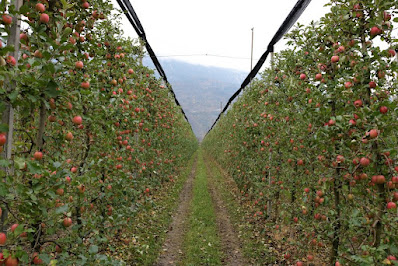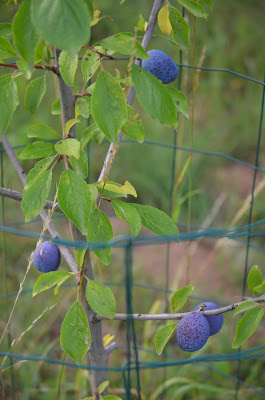The Apple (Malus domestica) originated in Central Asia, where it was domesticated from wild M. sieversii. The unusually sweet fruits were selected among the many species of sour wild 'crab' apples. Seeds would have been transported west to Europe along the silk road, and hybrids formed with native species along the way, including the Wild European Crab Apple (M. sylvestris). Such was the importance of the apple, that in the ancient Middle East it was used as the fruit in the creation myth of the Garden of Eden.
Apples have a lot of genetic variation. When two trees cross-fertilise, the young trees which grow from their pips will inherit the characteristics of both parents - looking different from both, and from each other (just like us). Since ancient times humans have used cross breeding to create new 'varieties' which are unique, for example in looks, taste, and timing of flowering and fruiting. However, this genetic variation also means that once a cultivar has been selected its characteristics will degrade when it cross-fertilises with another tree. To solve this, ancient Asian societies invented 'grafting' - a stem (scion) is simply cut and attached to a rootstock (the underground part of the tree), onto which it will grow into a 'clone' of its parent.
Rootstocks are the engines of trees, and their genetics will effect how big a tree will grow and where it will grow best. For agriculture to advance, farmers would need to be able to obtain reliable rootstocks with predictable properties best suited for them - as investing in a slow growing tree is a big risk. Enter Sir Ronald Hatton.
A Londoner by birth, Hatton was nephew of the famous statistician Karl Pearson (the founder of mathematical statistics). He studied history at Oxford but, after subsequently working on a farm, realised his true vocation and went to study agriculture at East Malling Research Station at Wye in Kent (where he would become director, and also publish a book titled 'Folk of the Furrow' under the nom de plume Christopher Holdenby). From 1912 Hatton catalogued apple rootstocks, numbering them in a series after the letter M for Malling. They became the international standard for apple production. Later, in collaboration with the John Innes Institute at Merton in South London (a few kilometres from where I grew up), aphid resistant varieties were developed which were designated (you guessed it) MM. Commerial apple orchards usually plant rootstocks for small trees (low M numbers), to be grown at high densities, which are trained and pruned heavily for convenience of management and to maximise quality and yield.
I'm not planting an orchard to make money or feed the world. I want to witness the magnificence of an apple tree fulfilling its genetic potential, and enjoy all the wildlife which that should bring. Hatton and his cloned M rootstocks are not for me. There is an alternative - seedling rootstocks (called franc in France), grown from apple pips. They have more genetic variation and are very vigorous - scions grafted onto them will grow into trees of over six metres in height, with the lowest branches around two metres from the ground.
The European Plum (Prunus domestica) is thought to have originated in the Middle East, as a hybrid of the Cherry Plum (P. cerasifera) and the Blackthorn (P. spinosa). In Europe there are four main plum groups: typical European Plums (from Eastern Europe, such as the Quetsche), the Agen Prune Plums (natives of my region, and the most economically important), Reine-Claude (named after the French 16th century Queen and imported into England as Greengages), and the Mirabelles (small often feral fruits used for jams). Plums also have a seedling rootstock - Myrobalan, grown from the pips of ancestral Prunus cerasifera. Trees grafted onto this rootstock can grow up to six metres in height.
Before the 20th century, most orchards had trees of this size. Today they are a rare sight, and their days are limited because, like humans, 100 years is an exceptional age even for big trees. In these ancient orchards, as in sparse woodlands, the open spaces around the trees were carpeted with wild flower meadows where, after the summer hay cut, livestock grazed under the high branches - captured here by British artists Nicholas Verrall and Janet Fischer.
It's a pretty bucolic scene, but in reality livestock can damage tree bark by rubbing against it and they will fertilize meadows with their feaces to the benefit of grasses over wild flowers - and I think there are too many domesticated farm animals in the world anyway. Probably better to substitute them with a scythe and a mower, using the standing space below the canopy, and enjoy visits from wild deer. The fruits of these trees need to be harvested by ladder, or collected as windfalls for cider, or just left for the wild birds, insects, and mammals to enjoy.
Having decided on my rootstocks, I had to choose the scions. There are over 7,000 varieties of apples, yet in Europe only fifteen make up 75% of the apples consumed - those that are uniform and easy to produce and sell. Leading these is the Heineken of apples, Golden Delicious.
Again I want genetic diversity, and I want varieties that were selected for local conditions with a unique history and character. I prefer to drink Westmalle Tripel. I'm a paid up member of CAMRA - the Campaign for Real Apples.
Local varieties on seedling root stock are not found at the local garden centre. In my region, Aquitaine, the place to go is the CVA in Agen - their mission to 'safeguard old fruit varieties of regional heritage'.
I chose twelve varieties of apples newly grafted onto franc, and three of two year old plum scions on myrobalan. I made sure that the varieties were as 'rustic' in character as possible, including those specifically suited to be eaten fresh, cooked, or made into cider. I also ensured that they would be spread over the year in flowering (for cross-pollination) and fruiting (for harvesting).
In January, Marianne and I dug holes and plonked trees in them.
Once the trees were planted, we fenced in each with a 1.3 metres high wire mesh to prevent nibbling by the roe deer which come into the garden most nights. The final result looked a bit pathetic - a far cry from the ancient orchards of oil paintings.The power of nature. By summer the orchard was already beginning to look like an orchard. All the trees produced healthy shoots and leaves. I mowed and mulched the rows through the year to return nitrogen into the soil. The meadow between the rows was left to be cut by the farmer for hay in mid-summer, and for the rest of the year I mowed it but took the cuttings away for composting - to remove nitrogen to keep the grass low and to encourage the Spring flowers.
One of the Quetsche even produced some fruit.
Nature works at its own pace. After five years my baby apple trees should become adults and bear fruit. In ten years they will enter the potency of maturity, then age into mellowed and wrinkled gentle giants. They will dress in lichen, and allow birds to pick twigs and nest in the safety of their huge canopies. And they will be joined by the laughter of children, climbing and swinging from the strong arms of their branches in the shade of the endless summer days of their adult reminiscences. And the old folks will look on with their Westmalle Tripels, and they will say that it was good.





















Is a Quetsche what we call a Zwetschge in CH?
ReplyDeleteYes. The original name in Latin was Damascenum - as they are believed to originate from Damascus in Syria. That's why we call them Damsons. The theory is that the barbarians couldn't speak Latin properly, and corrupted the name to Zwetschgen - which entered France as Quetsche through the Germanic dialects around Luxembourg. I think understanding the origin of plums and their names could be a life's work!
Delete